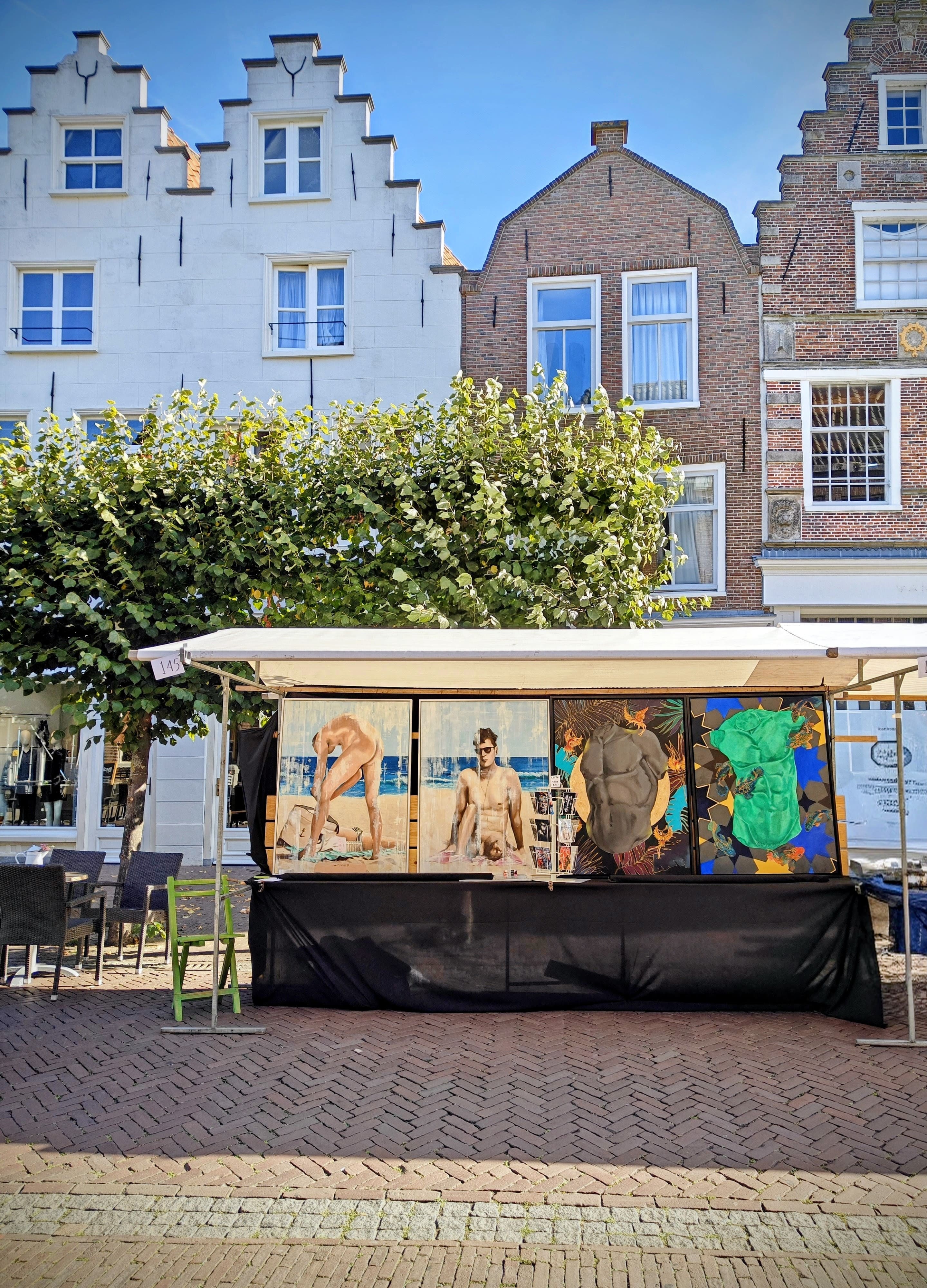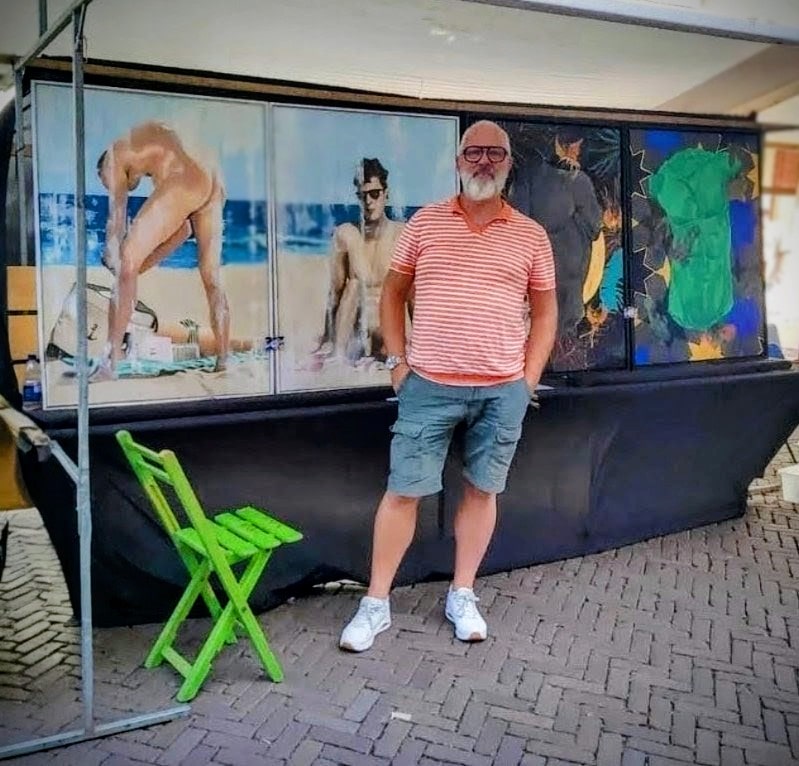2025-09-09
BEHIND THE PAINTINGS: Back on the Grote Noord
 Art, family, and visibility in Hoorn
Art, family, and visibility in Hoorn
Hoorn breathes history. As a VOC city, it flourished in the 17th century, sending ships to distant lands, importing spices, and cultivating craftsmanship. The gabled facades, cobblestones, and the old weigh house still whisper stories of trade, skill, and worldly ambition.
Among those facades, on the Grote Noord, my family history began. My direct ancestors ran a gold and silver shop at number 82, with a workshop that extended into the Nieuwe Noord. They crafted jewelry, medals, and timepieces — artisanal, precise, with a reputation passed down through generations. In a 1928 advertisement, it proudly read: “The address of trust.” And they were.
Two namesakes, Jacob and Rudolf van Straten, were co-founders of the drawing society Debutade in 1866. Whether they’re direct ancestors? Most likely. My grandfather was named Jacob. My father — and I — Rudolph / Rudolf. The names remain, as does the drive to create. Their presence in Hoorn’s art history feels like an echo. An artistic legacy I now revive — in my own way.
And now, generations later, I stand on the Grote Noord myself. Not as a craftsman, but as an artist. My torsos and portraits hang among the buildings where my family once worked. Not to sell, but to be seen. To claim space. To return.
A statement in the sun
I came across the Hoorn Art Market on Instagram. They still had spots open for participants. Honestly, I hadn’t heard of it before, but after some digging, I signed up and submitted my website for review. Soon after, I received the invitation to join. Time to prepare.
I quickly knew what I wanted to show. The booth was four meters wide — just enough for four canvases, each 90 x 120 cm. No clutter, no compromise. Hardly anyone in Hoorn knows me, apart from family, and my goal was clear: to make a statement. Unapologetic, uncompromising. This is me.
I chose Paradiso I & II — bold, but in my view, entirely tasteful. Male nudity. You don’t see that often, especially at an art market where most works are small and geared toward easy sales. But that wasn’t my aim. The two Greek torsos Midnight Paradise and The Dancing Faun told a deeper, layered story. Both in black, with vivid colors and gold foil details — a sharp contrast to the summery feel of Paradiso.
And we lucked out with the weather: a warm, late-summer Sunday, 26 degrees in early September. My booth was located on the Grote Noord, near number 25 — right next to the bustling terrace of De Vier Jaargetijden. Promising foot traffic and plenty of people.
My neighbors were an older couple selling handmade jewelry. Fitting, really. No competition for me, so I knew I’d stand out. We quickly set up the booth, draped it in black fabric: four paintings, a postcard rack, and a printed catalog of my work.
Reactions, conversations, recognition
By 10:30 we were ready. People were already strolling by. Everyone seemed to look. We sat back in the sun, watching from a distance — the perfect vantage point to observe reactions. Paradiso drew the most attention. People looked — and looked again. Some laughed: “Naked men…”
Women often reacted together, giggling: “I’d never hang that in my living room.” I replied: “Isn’t it great? Finally, naked men.” One of them said: “Oh, I love that!” “Well,” I said, “so do I.” She was startled, but it broke the ice. They walked off laughing.
At noon, the market officially began. I stood by my work and spoke to people when needed. Paradiso II sparked discussion. “Is that Herman Brood?” (a Dutch Rock icon) someone asked. People love to find something familiar. It kept them standing, looking, wondering. Eventually, I said: “It’s his brother — Herman Bloot.” (bloot=nude) Not everyone got the joke right away — but the conversation was alive.
Many people reacted. Some walked on, others came back for a second look. From the terrace, my booth was already visible — you could read reactions from body language alone. It was entertaining, sometimes moving, and surprisingly: many men responded. Some with a nod, others with a question, a smile, or quiet reflection. Some looked, walked on, then realized — and came back to look again.
I spoke with visitors, handed out business cards, and sold enough postcards to cover my costs. But more importantly: I showed my work. Without compromise. Without explanation. This is me.
A final encounter
Toward the end of the day, an older male couple passed by. They paused, looked closely, and approached the booth. One of them picked out four postcards. We started talking.
They told me that in Amsterdam, they’d visited a gallery and asked why there was no male nudity. The response? “Oh sir, that’s passé.” They were relieved to see my work. I told them I show it deliberately. “We need to stay visible,” I said. “As a gay community, as artists, as people.” They wholeheartedly agreed.
I showed them my catalog. They browsed, nodded, and took a business card with them.
Home, with a glass of wine
The day flew by. At five o’clock, it was over. We packed up the booth and headed home. That evening, with a glass of wine, we reflected on the day. And I can say: the impression was overwhelmingly positive.
I’m certain I made myself known in Hoorn.
“I wasn’t standing behind glass. I was standing among stories. My work hung where my family once worked. And the city looked back.”
Admin - 14:40:17 @ Behind the Paintings | Een opmerking toevoegen